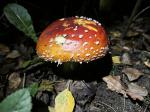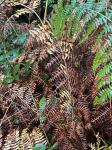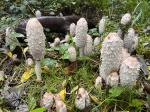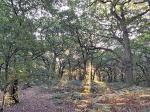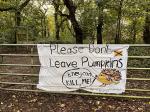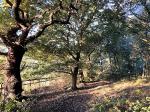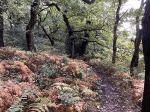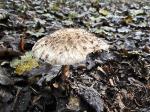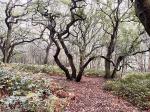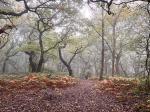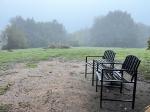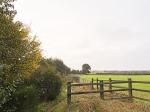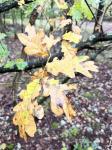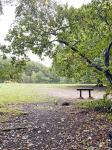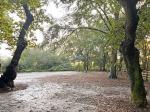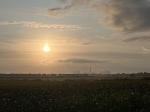Brayton Barff Through the Seasons.
Set in the Vale of York, South West of the market town of Selby and between the villages of Thorpe Willoughby and Brayton, lies Brayton Barff, a sandstone Hill approximately one hundred and fifty feet in height which was formed by glacial movement during the last Ice Age. It is a significant landmark in an otherwise flat landscape.
Today the site is primarily owned by Yorkshire Water with Selby District Council owning a small patch of the land adjacent to the A63 Selby bypass. A large underground reservoir occupies the centre of the site which delivers water to around 4.7 million customers throughout Yorkshire.
Within the Barff woodland over 40% of the trees are Sessile Oak which are generally found in semi natural woodlands in the north of the country. These trees are so called because its acorns are not held on stalks, like those of the English Oak (Pedunculate), but attached directly to the outer twigs. There are also several English Oak trees as well as some cross-hybrid oaks. These trees are known to support many species of flora and fauna, invertebrates, mosses, lichen and fungi.
During the Victorian times it is thought that the shipbuilders on the east coast would come over to the Barff for selected cuts of timber to build their sea going vessels.
The Barff also has a variety of other trees including Silver Birch, Beech, Sycamore, Holly, Rowan, Scots Pine, Alder, Hawthorne and European Larch. There are also several Yew, Willow, Hazel, Horse Chestnut and Wych Elm. As with similar woodlands there are a variety of bushes, including Honeysuckle, Elderberry, Gorse, Broom and Buddleia.
The history of Brayton Barff is quite vague, apparently during 1803 a beacon was lit on the Barff when the country was threatened with an invasion by Napoleon. In May 1935, to celebrate King George V's Silver Jubilee, a Bonfire was lit on the Barff as part of the celebrations.
Early issues of Ordnance Survey Maps dated 1903 clearly show a rifle range on the Barff, extending out to Mill Lane. During the 
Between 2001 – 2004 the A63 Selby bypass, 10km twin lane single carriageway was constructed which severed the South West corner of the Barff, adjacent to Selby Golf Course and resulted in a slight redesign of several holes on the golf course. Wooden fencing was erected as a result of this new road running alongside of the Barff and a footbridge constructed over the ‘new road’ following the line of the Bridal way which extends from Mill Lane. Around 2005/2006 a definite 2metre wide limestone aggregate footpath was laid forming a circular path around the outer edges of the woodland. This footpath is approximately 1.2 miles in length and takes about 30 minutes to circumnavigate at a leisurely pace.
In 2012 the Barff was declared an Ancient Oak Woodland and as such throughout 2012 and 2013 significant work had been carried out by the relevant agencies to cut and remove large swathes of non-native trees, creating at that time huge scars on the landscape. Some three years later the planting of the native trees have become well established and are flourishing. Ongoing maintenance work on the footpath around the bottom of the Barff was completed during the Summer of 2016.
A second phase of woodland maintenance commenced during the Autumn of 2019 with the removal of many old and diseased trees and the cutting back of the Gorse and Broom bushes, especially adjacent to the ‘bypass trail’, this work continued through till March 2020 with re planting continuing into April 2020.
Brayton Barff is a popular site for walkers and bird watchers alike and a path circling the outer perimeter of the Barff makes a pleasant thirty minute walk, giving views looking over towards Selby and the village of Brayton as well as the power stations of Drax and Eggborough..jpg)
For the early risers it is a great place to see some stunning sunrises over the villages of Brayton looking towards Drax Power Station, the same with the Sunsets looking over towards Eggborough and Monk Fryston.
The Barff changes with the Seasons and every visit can reveal something new, the woodland is a haven for wildlife. Records show that since 1982 one hundred and twelve species of bird have been seen in the woodland and at least 40 of those have bred here, including Tawny Owl, Buzzard, Green Woodpecker, Spotted Flycatcher, Goldcrest and Nuthatch to name just a few. On average over 70 species of bird are recorded each year. Further details of the bird life on the Barff can be found on the Brayton Barff Group Facebook page, especially the posts from Derek Cooper. Today ‘The Friends of Brayton Barff group’ led by Derek and a small team of volunteers help keep and maintain the cleanliness of the site as well as recording the wildlife and bird sightings.
The Barff is also home to fifteen different species of mammals, including Muntjac Deer, Pipistrelle Bat, Fox, and Field Vole.
Over eighty species of plant and wildflowers have been recorded, included Bee Orchid, Northern Marsh Orchid, Wood Anemone, Marsh Ragwort, Bluebell, White Bluebell, Bittersweet and Purple and White Foxgloves. Over twenty species of Butterfly have been recorded, including Marbled White, Brown Angus, Speckled Wood, Comma and Brimstone.
During the Autumnal months fungi thrives in this woodland environment, species including Fly Agaric, Beefsteak Tree Fungi, Chicken of the Wood, Sulphur Tufts, Stinkhorn, Ink cap, Puffballs and Hoof Bracket are just some of the many varieties that can be found here.
Click on the galleries shown below to expand the albums.
Tuesday 31st October 2023
After very heavy overnight rain on Sunday 1st October the morning started dull and wet but very humid. The temperature on the Barff at 7.30am was a barmy 17c.
Autumn is here in earnest, spiders are casting webs their all over the place, the lush green ferns that grew to over six feet tall during the summer months are beginning to die back, their leaves shrivelling up to just a fine golden brown skeleton, nettles are beginning to fade slightly though can still give you a nasty sting on the back of your hand if you brush up against one. The farmers were busy this morning harvesting their potatoes. This year's harvest must have been a nightmare for them due to the damp wet weather which has prevented them from lifting their crops on time, let alone carrying out the prep work for the winter.
The Grey Squirrels were extremely active amongst the leaf litter, busily chattering away to each other as they were stashing food for the colder winter months ahead, they have been active in my garden too and I live about a mile and a half away from the Barff.
Having been away on holiday for a several days during the first week in October, it was nice to be back on the Barff with Meg & Gracie. What a difference a few days away from the Barff can make especially at this time of year.
Sunday 8th was a dull, foggy, and humid morning, it was 16C on the Barff with little breeze, because of yesterday's strong wind the ground was covered in fallen acorns, twigs, and the leaves. The heavy overnight dew has made the ground very wet and slippery underfoot. It was nice to hear the dew drops falling on the tree canopy like rain. Birdsong was notably quiet today, though there were lots of Grey Squirrel’s scurrying about their business. The forecasted wet weather for our area has not yet materialised but my thoughts are with my friends in the Yorkshire Dales, and Scotland who are experiencing heavy rain and flooding at this moment.
It was good to see some movement around the hole in the road at the entrance to the car park this morning, most of the big blue water pipes look to have been fitted finally.
I was on the Barff for 7.00am on Monday 9th. We had another very heavy overnight dew, it was dark, dull, cloudy, and overcast. One of the highlights was listening to a Tawny owl calling over by the old farm shop.
Wednesday 11th was a very mild morning again,15c, there was no wind, and it was cloudy and overcast. Due to the humid weather, there has been an abundance of fungi on the Barff, especially the Birch Polypore, Earthballs and Sulphur Tuft. The Autumn colours are becoming stronger every day, ferns that have been prolific throughout the Spring and Summer are dying back and turning a lovely golden bronze colour, beech leaves are beginning to change into their autumnal colours. The acorns are starting to ripen, providing a winter fuel source for the Grey Squirrels, though there does not appear to be an abundance of them this year, the squirrels will have to supplement their winter diet with sweetcorn cobs which are being grown in the field adjoining the woodland.
Thursday 12th October was a much colder morning, temperature on the Barff at 8.00am had dropped to 5C and there was quite a chill in the air, I will soon have to get the winter gloves on.
Friday 13th was miserable, it was a wet and rainy day, I was late up and did not get on the Barff until 7.30am this morning. The autumn colours looking beautiful despite all the rain. Large clusters of Sulphur tuft fungi were popping up all over the woodland floor, especially on the ancient rotting tree stumps.
I had an early start on Saturday 14th October, which made up for yesterday's lateness, being on the Barff for 6.15am, it was dark with the sun slowly starting to rise in the east. What a contrast to the wet damp start of yesterday. This morning was bitterly cold, 5c, dry and no breeze. I stopped for a few moments between the old farm shop and car park (which is still closed) to listen to a solitary Tawny owl calling for its mate. Continuing our walk along the perimeter footpath, I stopped to have a look at the ongoing groundwork being carried out on the main road adjacent to the car park, I presume all the pipe work has been completed as they have filled in the large hole in preparation for the top layer of aggregate before being tarmacked.
Sunday 15th October was another early start, it was a bitterly chilly morning with an overnight ground frost, the first of this Autumn, (it did warm up slowly during the morning with sunshine, and by lunch time the thermometer was reading 11c.) The Tawny owl was making quite a commotion as were several Grey Squirrels playing a game of chase with each other, running up and down and around some of the old Beech trees at an alarming speed. Bird song seemed more active than of late, Robin, Wren and Song Thrush were very vocal in several areas of the woodland today.
There is a lot of fungi around on the woodland floor, I have just spotted some Fly Agaric on this morning's walk, it is such a colourful fungus. I have never seen as many Earthballs as there are now, Sulphur Tuft is popping up overnight on anything that is rotten. The Teasels have had a good year, there has been lots of them on the top of the Barff, some reaching heights of over six feet, alas they have all died back having been at their best during the summer months, the seeds of the teasel are very important for birds, such as the goldfinch, which can often be seen feeding on the old, brown flower heads this time of year, 'teasing' the seeds from them.
Wednesday 18th October was another early start being on the Barff for 6.30am. After a couple of morning of air frosts with the temperature hovering just above freezing, this morning's walk was ridiculously mild at 11C, with a slight breeze. After several weeks of disruption around the car park, the huge hole on the main road adjacent to the car park has finally been tarmacked, some groundwork must be done around the verge before the red protective barriers can be dismantled and traffic lights removed. Bird life was more notable this morning than of late, many of the usual regulars were flitting amongst the trees, including Blackbirds, Robins and Blue Tits, the tiny Wrens were singing their heads off. I am sure I would have hear more had I spent more time in the woodland.
Clumps of Sulphur Tuft, Shaggy Ink Cap and Earthballs continue to flourish on the woodland floor and have been for several weeks now, Birch Polypore and more Fly Agaric fungi are shooting up every day.
Thursday 19th October was a damp and overcast morning, it was noticeably quiet on the Barff. The weather forecast for the next 24 hours looks quite interesting with a yellow weather warning being issued for Yorkshire and Humberside as ‘Storm Babet’ is set to batter the country today with extremely heavy rain and strong winds. Up in central Scotland the forecasters are predicting as much as eight inches of rain could fall and winds could reach up to seventy miles an hour in that area.
It was good to see that the Barff car park has finally reopened to cars this afternoon.
On Friday 20th October we had a very wet walk, Storm Babet has arrived on the Barff, bringing with it high winds and heavy rain which battered the woodland, causing some damage to the trees, with twiglets and small branches littering the woodland floor. Autumnal leaves were falling like confetti. The intense winds and persistent rain lasted all day and into the evening, fortunately we have not seen any of the flooding or power cuts that other parts of Yorkshire have had to cope with.
Saturday 21st October and the rain continuing through Friday evening and finally abated at around 9.00am this morning. Reports in the local papers are saying that we have just had a months’ worth of rainfall in twenty-four hours. Fortunately, apart from yesterday, Storm Babet seems to have passed us by, with minimal damage on or to the surrounding area, unfortunately though, certain parts of the county have not been so lucky and have had to endure significand flooding and disruption especially in West and South Yorkshire.
Tuesday 24th October. I was on the Barff for 7.00am this morning. It was a very dark with only the light from my headlamp to show the way. We were walking along the top meadow on Tap Hill when I heard a Tawny Owl screeching in the trees in the distance, I got to within 50 yards of where the noise was coming from when the owl turned around to face me, its two bright orange eyes reflecting in my headlamp. Without getting too close and not wanting to disturb it further, I stopped in my tracks and headed off in the opposite direction towards Sherwood’s farm, by the time we had walked down the slope to the outer perimeter footpath there was another Tawny owl adjacent to the farm, making a similar screeching noise. I continued my walk along the perimeter footpath towards the car park.
Friday 27th was a very foggy, drizzly morning. My headlamp was more of a hinderance this morning as the white light just reflected in my face and the fine drizzle did not improve the visibility either. The rain over the past couple of days has made the woodland floor extremely wet, muddy, and slippery, which after all is to be expected this time of year. It was nice to hear the gently melodic bird song of a Wren and Robin this morning, having a sing off between themselves amongst the trees, only momentarily being disrupted by a squawking Jay.
The last day of the month Tuesday 31st was another very wet morning, the ground was still saturated, and the smaller tracks around the woodland becoming very wet and muddy. That said the autumn colours are looking beautiful, the Oak leaves are turning a yellow and golden-brown colour, Silver Birch leaves too are similar colour as are the Beach trees. The forestry people have been in amongst the woodland over the past couple of days and felled some random trees, their four wheeled vehicle cutting up the ground quite badly.
Bird song these past few mornings has been noticeably quiet except for the Robin and Wren who between them seem to be able to produce a song every day of the week no matter what the weather.
There have been several highlights for me this month, including bumping into the Tawny Owls on two consecutive mornings was amazing, seeing the variety of Fungi around at this time, the beautiful autumnal colours of the trees especially during the sunshine and finally listening to the Wren and Robin singing their early morning tunes.
|

